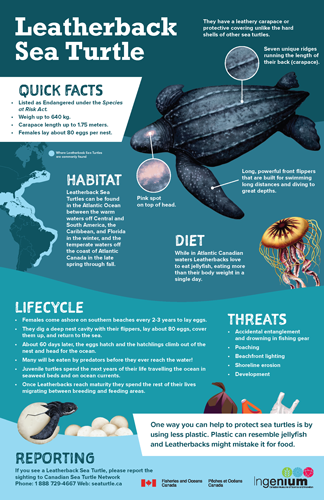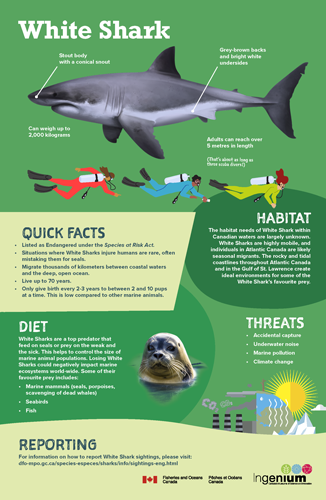**** Ingenium and Fisheries and Oceans Canada Release
Ingenium and Fisheries and Oceans Canada have teamed up to highlight some of the marine species found in Canadian waters that are currently listed as species at risk under the Species At Risk Act. Each of the posters found on this page highlight a specific species. You will see breathtaking illustrations of these animals and also learn about their habitat, diet, the threats they face, and more.
We invite you to download, print, and share these as often as you like and we hope that you will learn more about species at risk in Canada.
Species at Risk Posters
LEATHERBACK SEA TURTLE
Leatherback turtles are true giants of the sea. This poster talks about the species, where it can be found in our oceans, diet and reproduction, as well as threats to the species.
They have a leathery carapace or protective covering unlike the hard shells of other sea turtles.
Seven unique ridges running the length of their back (carapace).
Long, powerful front flippers that are built for swimming long distances and diving to great depths.
Pink spot on top of head.
Where Leatherback Sea Turtles are commonly found
Quick Facts
- Listed as Endangered under the Species at Risk Act.
- Weigh up to 640 kg.
- Carapace length up to 1.75 meters.
- Females lay about 80 eggs per nest.
Habitat
Leatherback Sea Turtles can be found in the Atlantic Ocean between the warm waters off Central and South America, the Caribbean, and Florida in the winter, and the temperate waters off the coast of Atlantic Canada in the late spring through fall.
Diet
While in Atlantic Canadian waters Leatherbacks love to eat jellyfish, eating more than their body weight in a single day.
Lifecycle
- Females come ashore on southern beaches every 2-3 years to lay eggs.
- They dig a deep nest cavity with their flippers, lay about 80 eggs, cover them up, and return to the sea.
- About 60 days later, the eggs hatch and the hatchlings climb out of the nest and head for the ocean.
- Many will be eaten by predators before they ever reach the water!
- Juvenile turtles spend the next years of their life travelling the ocean in seaweed beds and on ocean currents.
- Once Leatherbacks reach maturity they spend the rest of their lives migrating between breeding and feeding areas.
Threats
- Accidental entanglement and drowning in fishing gear
- Poaching
- Beachfront lighting
- Shoreline erosion
- Development
One way you can help to protect sea turtles is by using less plastic. Plastic can resemble jellyfish and Leatherbacks might mistake it for food.
Reporting
If you see a Leatherback Sea Turtle, please report the sighting to Canadian Sea Turtle Network
Phone: 1 888 729-4667 Web: seaturtle.ca
(Logos – Ingenium/Fisheries and Oceans Canada)
NORTH ATLANTIC RIGHT WHALE
It is believed that there are only a few hundred North Atlantic Right Whales in existence today. These extraordinary animals are unique to the North Atlantic. This poster will tell you more about them and what threatens them today.
North Atlantic Right Whale
V-shaped blow
Callosities
Baleen plates
No dorsal fin
Y-shape tail fluke
No throat grooves
Paddle shaped flippers
Skin black with occasional white patches
Where North Atlantic Right Whales can commonly be found in North America
One of the most endangered whale species in the world!
- Listed as Endangered under the Species at Risk Act.
- Population estimated at about 336 individuals left in the world in October 2021.
Quick Facts
- Callosity patterns are unique and allow scientists to identify individuals. They appear yellow or cream color due to the infestation of whale lice.
- Blubber can be as thick as 20 cm, which is about the length of an adult man’s hand.
- Adults weigh about 6000–7000 kg.
- Adults can reach up to 17 meters in length (That’s about as long as one and a half school buses!).
Diet
They feed on copepods, a small crustacean approximately the size of a grain of rice.
What is Being Done?
- Protection: The Government of Canada has established management measures to protect North Atlantic Right Whales.
- Detection: Aircraft and ships are used for visual observations and underwater acoustic technology is used to identify whale calls.
- Research: Scientists use photographs to identify individual North Atlantic Right Whales to study their health and migration patterns.
- Rescue: The Government of Canada and other teams work together to rescue North Atlantic Right Whales if one is in distress in Canadian waters.
Threats
- Vessel strikes
- Fishing gear entanglements
How You Can Help
Report whales you see by calling Fisheries and Oceans Canada at 1-844-800-8568
(Logos – Ingenium/Fisheries and Oceans Canada)
WHITE SHARK
The white shark, or great white shark is an apex predator critical to ocean health. Believe it or not there are often white sharks in the waters off of Atlantic Canada and their presence here is fascinating and essential. These majestic creatures are often misunderstood. This poster sheds light on the importance of white sharks in marine ecosystems.
Stout body with a conical snout
Grey-brown backs and bright white undersides
Can weigh up to 2,000 kilograms
Adults can reach over 5 metres in length (That’s about as long as three scuba divers!)
Quick Facts
- Listed as Endangered under the Species at Risk Act.
- Situations where White Sharks injure humans are rare, often mistaking them for seals.
- Migrate thousands of kilometers between coastal waters and the deep, open ocean.
- Live up to 70 years.
- Only give birth every 2-3 years to between 2 and 10 pups at a time. This is low compared to other marine animals.
Habitat
The habitat needs of White Shark within Canadian waters are largely unknown. White Sharks are highly mobile, and individuals in Atlantic Canada are likely seasonal migrants. The rocky and tidal coastlines throughout Atlantic Canada and in the Gulf of St. Lawrence create ideal environments for some of the White Shark’s favourite prey
Diet
White Sharks are a top predator that feed on seals or prey on the weak and the sick. This helps to control the size of marine animal populations. Losing White Sharks could negatively impact marine ecosystems world-wide. Some of their favourite prey includes:
- Marine mammals (seals, porpoises, scavenging of dead whales)
- Seabirds
- Fish
Threats
- Accidental capture
- Underwater noise
- Marine pollution
- Climate change
Reporting For information on how to report White Shark sightings, please visit: dfo-mpo.gc.ca/species-especes/sharks/info/sightings-eng.html
(Logos – Ingenium/Fisheries and Oceans Canada)







